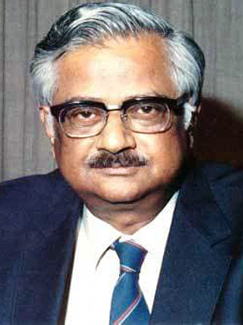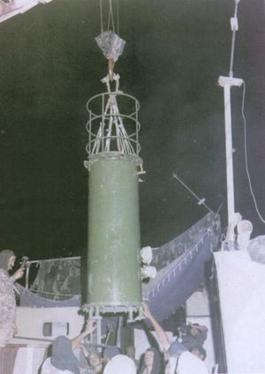S. K. Sikka | |
|---|---|
| Born | November 22, 1941 |
| Died | 21 June 2023 (aged 82) |
| Occupation(s) | Nuclear Condensed Matter physicist Crystallographer |
| Known for | Indian Nuclear Weapons Programme |
| Awards | Padma Shri H. K. Firodia award MRSI-ISCS Superconductivity and Materials Science Annual Prize M. M. Chugani Award of Indian Physics Association for applied physics Homi Jehangir Bhabha Medal of INSA Homi Bhabha Lifetime Achievement Award of Indian Nuclear Society Meghnad Saha Medal of National Academy Sciences DAE Lifetime Achievement Awards |
Satinder Kumar Sikka was an Indian nuclear condensed matter physicist, crystallographer [1] and a former Scientific Secretary to the Principal Scientific Advisor of the Government of India. [2] [3] He was known to have played a crucial role, along with Raja Ramanna, Rajagopala Chidambaram and Basanti Dulal Nagchaudhuri, in the design and development of a Hydrogen Bomb by India, [4] which was tested at the Pokhran Test Range in May 1998, under the code name, Operation Shakthi. [5] He was also involved in the Smiling Buddha tests, conducted in 1974. [6] He was awarded the fourth highest civilian award of the Padma Shri, by the Government of India, in 1999. [7]
Satinder Kumar Sikka was born in Jhang Maghiana ( now in Pakistan )in undivided India on 22 November 1942, [8] three months after the Quit India Movement was launched. [6] He graduated (BSc) from the Punjab University in 1960 after which he started his career by joining the Bhabha Atomic Research Centre Training School. [9] While at BARC, he did research under Rajagopala Chidambaram, the renowned nuclear physicist who would later become his associate in the Pokhran tests, and secured a doctoral degree (PhD) from Mumbai University in 1970. His research during this period were centered around the topics of neutron diffraction, X-ray crystallography, and high pressure and Shock wave physics. [9] He served BARC till 2002, holding several key positions such as that of the Director of Atomic and Condensed Matter Physics Group. In 2002, he was appointed as the Scientific Secretary to Principal Scientific Adviser of the Union Government and he continued his association with the office, even after his superannuation, first as a Scientific consultant to the Principal Scientific Adviser and then, as a member of the Scientific Advisory Committee to the Cabinet (SAC-C). [10] He was the Homi Bhabha Chair Professor at the Bhabha Atomic Research Centre from 2010 to 2013. He died on 21 June 2023.
Sikka's early research on neutron diffraction and his studies of the Phase problem employing anomalous and direct scattering methods have been accepted by the International Union of Crystallography and has been incorporated in their teaching aids. [9] In 1969, he was included in the team of scientists for the Indian Nuclear Weapons Programme and was a member of the Smiling Buddha team which successfully tested the first Indian nuclear bomb on 18 May 1974. [9] He continued his involvement with the team and was the head of the thermonuclear device development team of the Pokhran-II test of 1998. [11] It is reported that Rajagopala Chidambaram, his mentor at BARC, entrusted the responsibility of the development of the thermonuclear test device to Sikka, [12] after consultation with the then Prime Minister of India, P. V. Narasimha Rao. [13] Sikka, receiving the instructions, set up a laboratory with facilities for static pressure generation employing diamond anvil cells and shock waves generation with gas guns, the first such laboratory in India. [9] The research here assisted in the development of computer codes for design, simulation and yield estimates of nuclear explosives [9] and, aided by these work, he is known to have developed a freshly designed device using a boosted fission bomb primary, to be used on a ballistic missile. [13] His research has been documented by way of over 150 articles, [9] published in national and international peer reviewed journals. [14] [15]
Sikka served as a member of the Executive Committee of the International Association for Advancement of Research and Technology under High Pressure from 1997 to 2000 and as a consultant to the Commission on High Pressure of International Union of Crystallography from 2002 to 2006. [9] He has chaired the INSA committees for the International Union of Crystallography and Committee on Data for Science and Technology and has served as a member of the Asia Pacific Academy of Materials and the editorial board of High Pressure Research journal. [9]
Sikka holds the honorific title of the Distinguished Scientist of the Bhabha Atomic Research Centre. [9] The Indian National Science Academy elected him as their Fellow in 1988. [9] Two years later, the Indian Academy of Sciences followed suit and elected him as a Fellow. [8] In 1998, he was awarded the H. K. Firodia award for Excellence in Science and Technology, [16] one year before he received the fourth highest Indian civilian award of the Padma Shri. [7] He was selected for the MRSI-ISCS Superconductivity and Materials Science Annual Prize in 2001 and the Indian Physics Association awarded him the M. M. Chugani Award for Excellence in Applied Physics in 2002, [9] before the National Academy of Sciences, India elected him as their Fellow in 2003. [17] Indian National Science Academy honoured him with Homi Jehangir Bhabha Medal for Experimental Physics in 2005. Indian Nuclear Society gave him the Homi Bhabha Lifetime Achievement Award of in 2007. [9] The National Academy of Sciences, Allahabad gave him Meghnadh Saha Medal in 2010. The Department of Atomic Energy awarded him the Lifetime Achievement Award in 2011. [18]

Operation Smiling Buddha or Operation Happy Krishna was the assigned code name of India's first successful nuclear bomb test on 18 May 1974. The bomb was detonated on the army base Pokhran Test Range (PTR), in Rajasthan, by the Indian Army under the supervision of several key Indian generals.

India possesses nuclear weapons and previously developed chemical weapons. Although India has not released any official statements about the size of its nuclear arsenal, recent estimates suggest that India has 164 nuclear weapons and has produced enough weapons-grade plutonium for up to 200 nuclear weapons. In 1999, India was estimated to have 800 kilograms (1,800 lb) of separated reactor-grade plutonium, with a total amount of 8,300 kilograms (18,300 lb) of civilian plutonium, enough for approximately 1,000 nuclear weapons. India has conducted nuclear weapons tests in a pair of series namely Pokhran I and Pokhran II.

Raja Ramanna was an Indian physicist who is best known for his role in India's nuclear program during its early stages.

Homi Jehangir Bhabha, FNI, FASc, FRS, Hon.FRSE was an Indian nuclear physicist who is widely credited as the "father of the Indian nuclear programme". He was the founding director and professor of physics at the Tata Institute of Fundamental Research (TIFR), as well as the founding director of the Atomic Energy Establishment, Trombay (AEET) which was renamed the Bhabha Atomic Research Centre in his honour. TIFR and AEET served as the cornerstone of the Indian nuclear energy and weapons programme. He was the first chairman of the Indian Atomic Energy Commission and secretary of the Department of Atomic Energy. By supporting space science projects which initially derived their funding from the AEC, he played an important role in the birth of the Indian space programme.

Tata Institute of Fundamental Research (TIFR) is an Indian Research Institute under the Department of Atomic Energy of the Government of India. It is a public deemed university located at Navy Nagar, Colaba in Mumbai. It also has campus in Bangalore, International Centre for Theoretical Sciences (ICTS), and an affiliated campus in Serilingampally near Hyderabad. TIFR conducts research primarily in the natural sciences, the biological sciences and theoretical computer science.

Anil Kakodkar, is an Indian nuclear physicist and mechanical engineer. He was the chairman of the Atomic Energy Commission of India and the Secretary to the Government of India, he was the Director of the Bhabha Atomic Research Centre, Trombay from 1996 to 2000. He was awarded the Padma Vibhushan, India's second highest civilian honour, on 26 January 2009.

The Bhabha Atomic Research Centre (BARC) is India's premier nuclear research facility, headquartered in Trombay, Mumbai, Maharashtra, India. It was founded by Homi Jehangir Bhabha as the Atomic Energy Establishment, Trombay (AEET) in January 1954 as a multidisciplinary research program essential for India's nuclear program. It operates under the Department of Atomic Energy (DAE), which is directly overseen by the Prime Minister of India.

The Homi Bhabha National Institute (HBNI) is an Indian deemed university established by the Department of Atomic Energy, which unifies academic programmes of several of its constituent institutions. Deemed universities in India have been divided in three categories by the Ministry of Human Resource Development (MHRD) and HBNI has been placed in category 'A', highest of the three categories. Homi Bhabha National Institute, Mumbai and its Constituent Units are the institutions of excellence as per section 4(b) of "The Central Education Institutions Act, 2006".

The Pokhran-II tests were a series of five nuclear bomb test explosions conducted by India at the Indian Army's Pokhran Test Range in May 1998. It was the second instance of nuclear testing conducted by India; the first test, code-named Smiling Buddha, was conducted in May 1974.

Srikumar Banerjee was an Indian metallurgical engineer. He retired as the chairman of the Atomic Energy Commission of India (AECI) and the secretary of Department of Atomic Energy (DAE) on 30 April 2012. Prior to his stint as DAE chairman, he was the director of Bhabha Atomic Research Centre (BARC) from 30 April 2004 to 19 May 2010. He had also served as a DAE Homi Bhabha Chair Professor at Bhabha Atomic Research Centre, Mumbai. He was known as a great physical metallurgist.
The Atomic Energy Commission of India is the governing body of the Department of Atomic Energy (DAE), Government of India. The DAE is under the direct charge of the Prime Minister.

Rajagopala Chidambaram is an Indian Physicist who is known for his integral role in India's nuclear weapons program; he coordinated test preparation for the Pokhran-I (1975) and Pokhran-II (1998).
Padmanabhan Krishnagopala Iyengar, was an Indian nuclear physicist who is widely known for his central role in the development of the nuclear program of India. Iyengar previously served as the director of BARC and former chairman of the Atomic Energy Commission of India, he raised his voice and opposition against the nuclear agreement between India and the United States and expressed that the deal favoured the United States.
Chaitanyamoy Ganguly is an Indian nuclear scientist and a former head of the Nuclear Fuel Cycle and Materials Section of the International Atomic Energy Agency (IAEA), credited with many innovations in the field of nuclear material science. He was honored by the government of India in 2002, with the fourth-highest Indian civilian award of Padma Shri.
Jai Pal Mittal is an Indian scientist, DAE Raja Ramanna Fellow of Bhabha Atomic Research Centre and Distinguished Professor of Indian Institute of Technology, Mumbai, the National Academy of Sciences, India and the University of Pune. He is known for his researches in the fields of photochemistry and radiation chemistry. He was honoured by the Government of India in 2003 with Padma Shri, the fourth highest Indian civilian award.

Valangiman Subramanian Ramamurthy is an Indian nuclear physicist with a broad range of contributions from basic research to Science and Engineering administration.Prof.Ramamurthy started his career in Bhabha Atomic Research Centre, Mumbai in the year 1963. He made important research contributions in the area of nuclear fission, medium energy heavy ion reactions, statistical and thermodynamic properties of nuclei and low energy accelerator applications. During the period 1995-2006, Prof.Ramamurthy was fully involved in Science administration as Secretary to Government of India, Department of Science and Technology, (DST), New Delhi.Other important assignments held by him include Director, Institute of Physics, Bhubaneswar, (1989-1995), DAE Homi Bhabha Chair in the Inter-University Accelerator Centre, New Delhi (2006-2010), and Director of the National Institute of Advanced Studies, Bengaluru (2009-2014). He is a former chairman of the Recruitment and Assessment Board of the Council of Scientific and Industrial Research and has served as a member of the design team of the first Indian nuclear experiment in Pokhran on 18 May 1974. The Government of India awarded him the third highest Indian civilian honour of Padma Bhushan in 2005.
Dilip Devidas Bhawalkar is an Indian optical physicist and the founder director of the Raja Ramanna Centre for Advanced Technology (CAT), an institute under the Department of Atomic Energy, serving as a centre for higher studies in the fields of lasers and particle accelerators. He is credited with pioneering research in optics and lasers in India and is reported to have contributed in making CAT a partner in the International Linear Collider and Large Hadron Collider experiments of the European Organization for Nuclear Research (CERN). He is a recipient of the Shanti Swarup Bhatnagar Prize, the highest Indian award in science and technology. The Government of India awarded him the fourth highest civilian award of the Padma Shri in 2000.
Krishna Balaji Sainis is an Indian immunologist. He is a former senior professor of Life Sciences at Homi Bhabha National Institute and an elected fellow of the National Academy of Sciences, India. Since 1999, he has served as the Indian representative on the United Nations Scientific Committee on the Effects of Atomic Radiation. The Council of Scientific and Industrial Research, the apex agency of the Government of India for scientific research, awarded him the Shanti Swarup Bhatnagar Prize for Science and Technology for his contributions to medical sciences in 1994.
Shyam Sunder Kapoor is an Indian nuclear physicist and a former director of Bhabha Atomic Research Centre. Known for his research on fission and heavy-ion physics, Kapoor is an elected fellow of all the three major Indian science academies – Indian Academy of Sciences, Indian National Science Academy and National Academy of Sciences, India – as well as the Institute of Physics. The Council of Scientific and Industrial Research, the apex agency of the Government of India for scientific research, awarded him the Shanti Swarup Bhatnagar Prize for Science and Technology, one of the highest Indian science awards, for his contributions to Physical Sciences in 1983.

Vasudeva Kilara Iya is an Indian nuclear scientist and the First Head of the radioisotope and radiation technology programme of the Department of Atomic Energy (DAE) and a former Group Director at BARC (1974–1987).